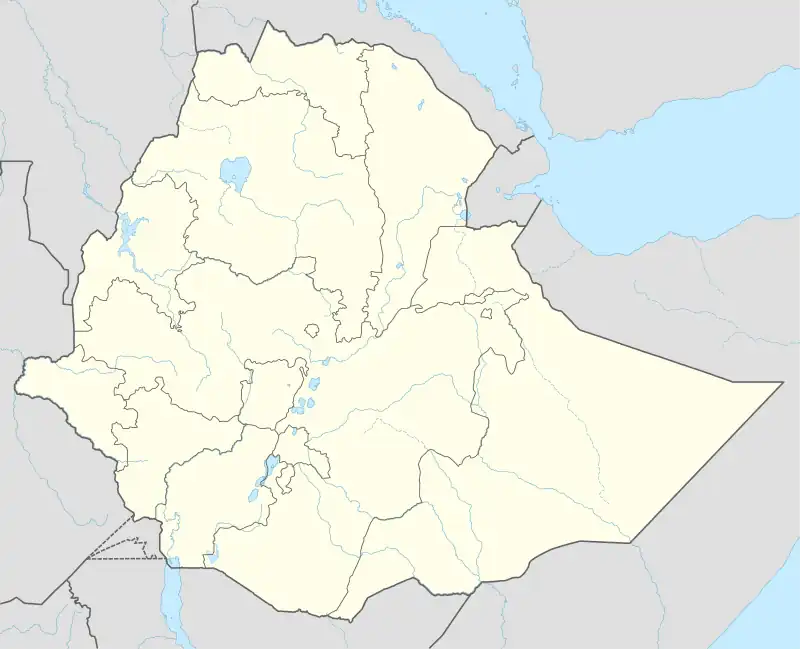Butajira
ቡታጅራ | |
|---|---|
Town | |
 Butajira Location within Ethiopia | |
| Coordinates: 8°7′15″N 38°22′45″E / 8.12083°N 38.37917°E | |
| Country | |
| Region | |
| Zone | East Gurage Zone |
| Elevation | 2,131 m (6,991 ft) |
| Population (2007) | |
| • Total | 33,406 |
| Time zone | UTC+3 (EAT) |
| Climate | Cwb |
Butajira (Amharic: ቡታጅራ) is a town and separate woreda in central Ethiopia. Located at the base of the Zebidar massif in the East Gurage Zone of the Central Ethiopia Regional State, Butajira has an elevation of 2131 meters above sea level. It is surrounded by Meskan woreda. It was part of former Meskanena Mareko woreda.
Overview

Butajira was founded between 1926 when a missionary Pere Azaiz found nothing there, and 1935 when a German ethnographic expedition found a town laid out in straight lines and square shapes to serve as the administrative center of the Gurage people. After Ras Desta Damtew was taken prisoner on 24 February 1937 in the small village of Eya he was brought to Butajira where, after a perfunctory trial, he was executed that evening. British patrols, acting as part of the East African Campaign, found that arbegnoch groups had dispersed the local Italian positions, leading to both the British and Ethiopian flags being raised over the town on 21 April 1941.[1]
According to the Gurage Zone government, as of 2007 Butajira is one of 12 towns with electrical power, one of 11 with telephone service, and one of nine that have postal service in the Gurage Zone. drinkable water is provided by 4 boreholes.[2] The town has a weekly market on Fridays. Notable landmarks in the town include a fountain on the south side of the town, which is fed from a sacred spring dedicated to saint Tekle Haymanot.[1] The zone authorities mention another local landmark is the local mosque (constructed by the financial contributions of both Muslims and Christians), which was completed in 1979 (1972 EC), and has two large praying halls, each with room for 2500 individuals: the hall on the ground floor is for women while the hall on the second floor is for men.[3]
Roughly 10 kilometers from Butajira is Butajira Crater Lake, which was created by phreatic eruptions.[4][5]
Demographics
Based on the 2007 Census conducted by the CSA, this town has a total population of 33,406, of whom 16,923 are men and 16,483 women. The majority of the inhabitants were reported as Muslim, with 51.27% of the population reporting that belief, while 39.58% practice Ethiopian Orthodox Christianity, and 8.72% were Protestants.[6] The 1994 national census reported this town had a total population of 20,509 of whom 9,827 were men and 10,682 were women. As of 2011, the total fertility rate was estimated to be 5.3 children per woman, and the total marital fertility rate was estimated to be 7.8 children per married woman.[7]
Health
A 2021 study revealed high rates of under-immunization in young children, with just 22.4% of children aged 12 to 23 months being fully immunized.[8]
As of 2010, Butajira has relatively low prevalence of malaria, with less than 1% overall prevalence. Prevalence varies among villages in the area and tends to be lower with higher altitudes.[9]
References
- 1 2 "Local History in Ethiopia" Archived 2007-09-27 at the Wayback Machine The Nordic Africa Institute website (last accessed 31 May 2008)
- ↑ Gurage Zone Socio-Economic Profile Archived 2007-10-07 at the Wayback Machine Gurage Zone Government web page (accessed 4 September 2007)
- ↑ "Tourisms" Archived 2010-11-29 at the Wayback Machine, Gurage Zone Government website (accessed 11 August 2009)
- ↑ "Butajira-Silti Volcano, Ethiopia | John Seach". volcanolive.com. Retrieved 2022-07-21.
- ↑ "Butajira, Ethiopia". volcano.oregonstate.edu. Retrieved 2022-07-21.
- ↑ Census 2007 Tables: Southern Peoples, Nations and Nationalities Region Archived November 13, 2012, at the Wayback Machine, Tables 2.1, and 3.4.
- ↑ Mekonnen, Wubegzier; Worku, Alemayehu (2011-10-10). "Determinants of fertility in rural Ethiopia: the case of Butajira Demographic Surveillance System (DSS)". BMC Public Health. 11 (1): 782. doi:10.1186/1471-2458-11-782. ISSN 1471-2458. PMC 3201928. PMID 21985493.
- ↑ Ketsela, Admassu; Gebreyesus, Seifu Hagos; Deressa, Wakgari (2021-05-10). "Spatial distribution of under immunization among children 12-23 months old in Butajira HDSS, southern Ethiopia". BMC Pediatrics. 21 (1): 226. doi:10.1186/s12887-021-02690-4. ISSN 1471-2431. PMC 8108332. PMID 33971837.
- ↑ Woyessa, Adugna; Deressa, Wakgari; Ali, Ahmed; Lindtjørn, Bernt (2012-03-23). "Prevalence of malaria infection in Butajira area, south-central Ethiopia". Malaria Journal. 11 (1): 84. doi:10.1186/1475-2875-11-84. ISSN 1475-2875. PMC 3383546. PMID 22443307.